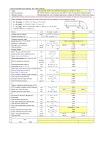
Hot tapping is an alternative procedure that makes a new pipeline connection while the pipeline remains in service, flowing natural gas under pressure. The hot tap procedure involves attaching a branch connection and valve on the outside of an operating pipeline, and then cutting out the pipe-line wall within the branch and removing the wall section through the valve. Hot Tapping makes it possible for pipeline owners and operators to isolate and bypass sections of pipeline so they can complete their projects without shutting down the system or losing product.
Hot tapping is an inherently dangerous operation. Therefore, hot tapping should generally be used only when it is impractical to take the system out of service. When specifying hot tapping, care is required in inspection, design, and testing to ensure that this operation is done in a safe and reliable manner. Therefore, a hot tapping should be considered only after other options are evaluated and rejected. Each hot tapping should be properly designed, the hot tapping location thoroughly inspected, and the installation procedures reviewed.
- Mount the hot tapping machine to the piping system.
- Advance cutter/pilot assembly until it touches the parent pipe, then start the hot tap.
- When cutter/pilot is completely through, stop rotation & advance to allow u-wires to drop.
- Coupon and cutter are withdrawn with the coupon or cut out retained by the u-wires.
- The fluid flow in the pipe is stopped between the two consecutive hot tap locations and a by-pass arrangement is made for maintaining the regular flow in piping system.
- The fluid present between the two consecutive hot tap locations is drained out using a vent (for gaseous fluid) or a drain (for liquid fluid).
- Modification between the two hot tap locations are completed using cutting and welding. This can be installation of any valve or a pipe piece.
- Fluid is again filled between the two hot tap locations ensuring the original pressure is maintained.
- Fluid flow is started again from the main pipe and by-pass arrangement and hot tapping machine is removed.
- If by inspection and calculation the wall thickness is less than minimum wall thickness for that alloy, schedule, and service. If below the minimum wall thickness the system should be shut down for repairs immediately.
- If the alloy, service, or metal thickness requires stress relieving of welds.
- In hydrogen and hydrogen rich (30% or greater) services because of tendency to leak through packing glands and potential hydrogen embrittlement of the metal.
- On flammable material lines containing air or oxygen because of potential detonation.
- On compressed air lines or air receivers because of the possibility of residue lubricating oil or carbonaceous material, which may ignite.
- On hydrocarbon systems operating under a vacuum because of potential detonation.
- On any vessel under vacuum.
- On systems containing acid, caustic, amine, or elemental sulfur because these materials can cause a metallurgical change in the metal and may require stress relieving, unless a variance is given by appropriate supervision.
- On cold service lines or equipment where a minimum metal temperature of 50ºF cannot be maintained throughout the process (cooling water is an exception).
- On thin wall pipelines where fluid temperature is so high that there would be a risk that the heat of welding / cutting would not be dissipated, unless a variance is given by appropriate supervision.
Hot Tapping Guidelines :-
- Hot Tapping equipment shall utilize a multi-rail alignment systems, packing housings with multiple o-rings seals rated for a minimum of 150% of the system being tapped (temp & press), heavy-duty variable speed drive motors with clutch assemblies, etc. Provide information on equipment for review.
- A Facilities Operations Group (FOG) or System Owner representative shall be present during the actual drilling operation of the Hot Tap work.
- A continuous flow of product must be maintained through the pipe being Hot Tapped, welded, or cut during the entire operation to carry off heat.
- When performing Hot Work on the outside surface of a pipe, precautions should be in place to protect against overpressure resulting from thermal expansion of the contents.
Listed below are the standard cutter sizes used when performing hot taps. This list is meant for reference only and does not refl ect the actual size used on any particular hot tap. Various conditions will determine the size necessary to complete the hot tap successfully. If a certain cutter size is required, please specify that size when ordering your hot tap.












-page-001.jpg)

1 Comments
Any hot tappers, stopplers, or pipe freezers out there that want to join a technical support group? At quora.com, I started a group called "Hot Tapping, Stoppling, & Freezing Piping". Get on Quora and join.
ReplyDelete